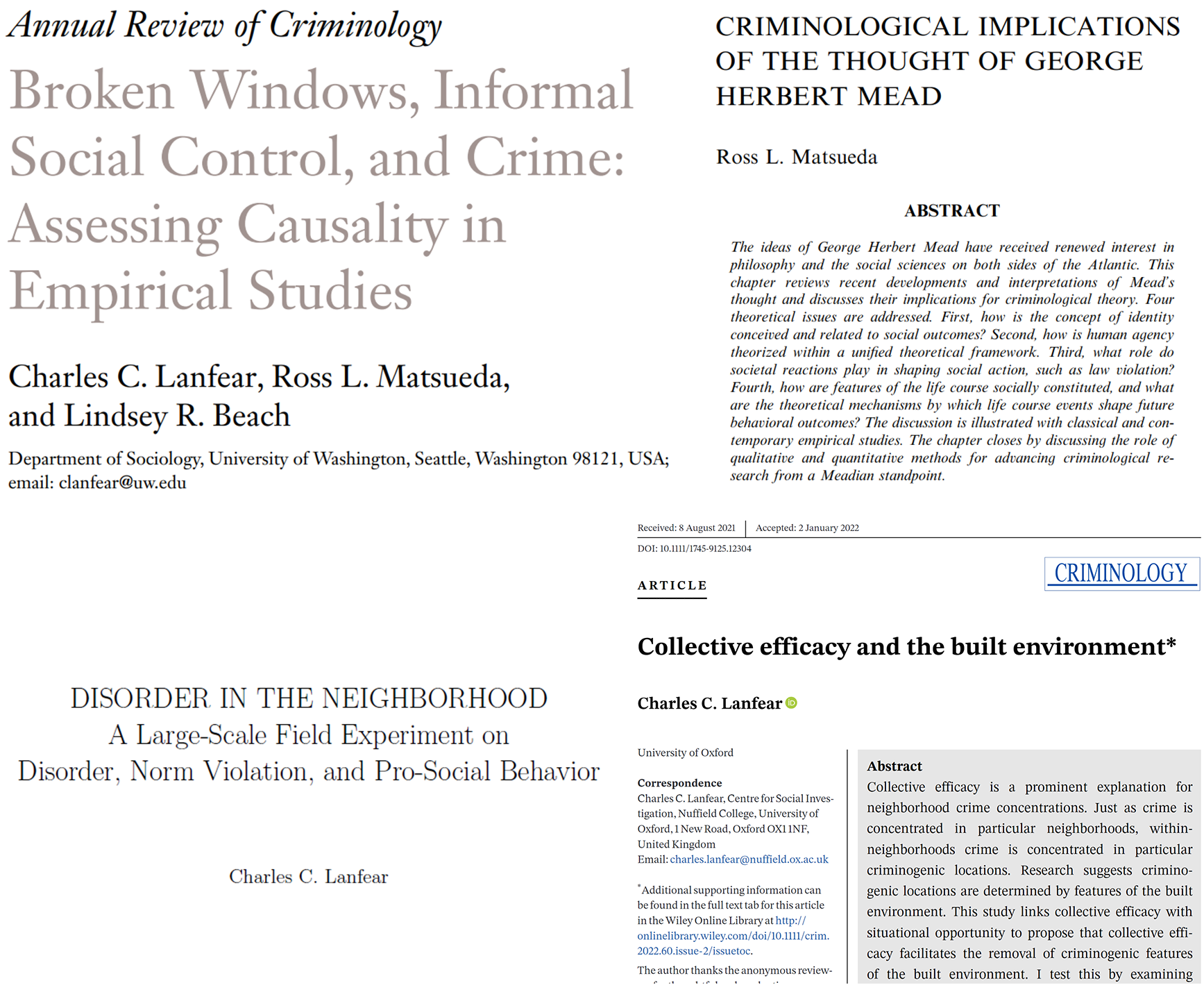A Micro Theory of Crime Opportunities
Symbolic interaction among motivated offenders, suitable targets, and capable guardians
Origin

Problem: Major macro-level theories have unarticulated or incomplete micro-level mechanisms, e.g.:
- Collective efficacy
- Broken windows
Goal 1: Specify social mechanisms compatible with core claims and empirical evidence
- Perception, motivation, meaning
- Strategic action and selection
- Inter-level causal mechanisms
Goal 2: Establish identifying assumptions for macro-analyses
Macro-Structural Theories
Collective Efficacy
A recursive macro model
Rooted in social capital and collective action
Collective Efficacy
Mechanisms typically implied: norms, perceptions, deterrence
Collective efficacy is an emergent social structure
Broken Windows
Same elements as collective efficacy but non-recursive
Equilibriating and cascade effects
Broken Windows
Explicit mechanisms: Deterrence, perceptions
Recursive with micro-model
Selection as an externality problem
Community Theories
Collective efficacy and broken windows have incompletely articulated models of situations and individuals
- Opportunity absent in particular
Rely heavily on perceptions as mediating mechanisms
- e.g. disorder, solidarity, support, risk
Social effects and structures: Emergence, norms, cascades
Language of routine activity theory useful for connecting these theories and introducing opportunity
Routine Activity
- Emphasizes objective opportunities and selection
- Routine activity’s micro-theory is a non-falsifiable postulate
- Abstract crime-relevant roles
Routine activity theory provides a simple, unifying language
- Collective efficacy increases real and perceived guardians
- Disorder increases and signals absence of guardians
Communities can also control crime by:
- Hardening targets (e.g., environmental interventions)
- Excluding offenders (e.g., enforcing boundaries)
- Invoking guardians (e.g., police, place managers)
Problems:
- No micro-theory of crime-relevant roles
- Objective and subjective opportunity may diverge
A Micro-Theory of Opportunity
We propose a situational micro-theory of roles, perception, and motivation based on criminological theory1 and pragmatist thought.2
- Link social structure and physical environment to distribution of crime-relevant roles in space and time
- Consider strategic actions to alter distributions
- Specify how situational outcomes change social structures
- Highlight challenges for empirical macro-analyses
Routine Activity Role-Identities
Analytical categories of motivated offender, suitable target, and capable guardian correspond to social roles
- Encompass meanings attributed to self, others, and objects
- e.g., perceiving others as motivated offenders
- Vary in salience and commitment
- e.g., influencing deterrence susceptibility
- Shape habitual and deliberate behavior
- e.g., governing crime-relevant selection
- Change as actors redefine situations
Role-Identities
For a law-abiding person with little criminal motivation, an unguarded open cash register would mean that someone should alert a sales clerk of a potential problem; for a motivated offender, it would mean that they could steal money with impunity. In other words, what is important is not just the objective opportunity, but rather the opportunity as perceived by the individual, which is based on a priori meanings actors bring into the situation, which are then shaped by the ongoing social process.
Symbolic Interaction
Symbolic interaction elaborates processes of learning, selection into situations, social action, emergence of shared meanings
We use this framework to clarify assumptions for identification and when micro-processes bias macro-analyses, e.g.:
If subjective opportunities ≠ objective opportunities
- Estimated opportunity effects are attenuated
- Association declines with novelty / heterogeneity
- Adjustment using perception antecedents
If and where emergence occurs
- Widespread bias unless orthogonal to covariates
- Bias Low: Institutionalized settings / homogeneous actors
- Bias High: Novel situations / heterogeneous actors
- Form determines appropriate design
- Widespread bias unless orthogonal to covariates
Implications for Theory
Connects core community theories to broad literature, e.g.:
Cultural theories1
Situated transactions2
Signal crimes3
Life-course4
Environmental criminology5
Collective action6
Questions
Thank you!